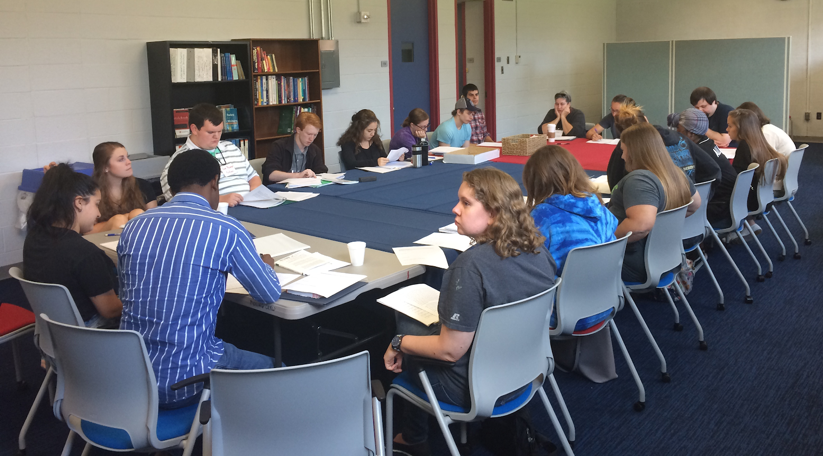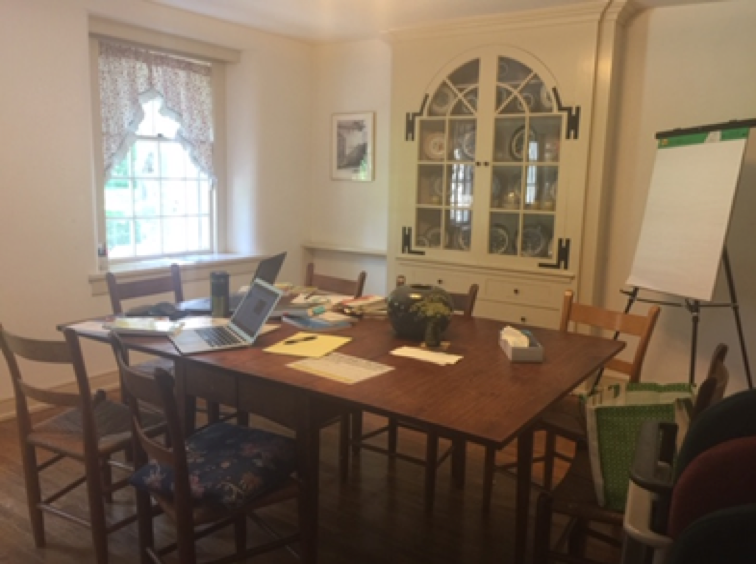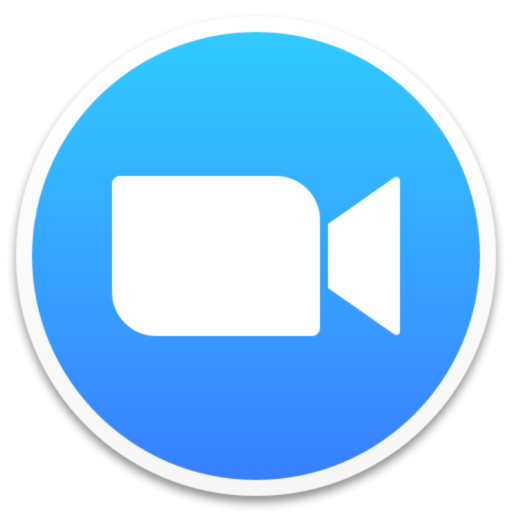
GENESIS
Digital Collaboration in
Writing Center Scholarship
HOW WE TEACH WRITING TUTORS
Karen Gabrielle Johnson
Shippensburg University
Ted Roggenbuck
Bloomsburg University

Wherever and however they exist, writing centers depend on effective tutors. And we understand that the key to helping tutors grow in their effectiveness is establishing an initial and ongoing tutor education program for our institutional context. To provide that education, we research best practices and draw upon the knowledge and experience of the writing center community to inform our pedagogy. Our community's knowledge, embedded in books, conference sessions, listservs, websites, and friends we collaborate with on projects, establishes a strong foundation to build practices and challenges us to consider new ways of building tutor expertise. This strong foundation, however, can be extended online to enrich our knowledge and practices. When we take advantage of digital affordances, teaching materials can be shared, human voices can be heard, research methods and materials can be examined, and links to articles, websites, and artifacts can be easily accessed.
This Digital Edited Collection (DEC) seeks to extend the writing center community of knowledge by sharing effective pedagogy and research through digital affordances to enrich our understanding of writing center work. Looking over the digital chapters we have collected here, we are excited by the abundance of resources they provide that would not be possible in a print text. Our authors offer links to videos, graphics, teaching materials, or artifacts used in their centers that we hope will be valuable to both new and experienced writing center professionals everywhere. We are also excited that this new open-access collection will be available to audiences who may otherwise find it difficult to access writing center scholarship. Looking back over our several months of collaborating on this project, we are both proud of it and relieved to have completed it. Looking forward, we anticipate continued collaboration with each other and with the wonderful and dedicated writing center scholars with whom we have worked to offer this collection.
WLN's First Digital Edited Collection (DEC)
In Open-Access, Multimodality, and Writing Center Studies, Elisabeth Buck, who has contributed a chapter to this collection, highlights problems of access individuals face when trying to find articles or research (93). Barriers such as insufficient funds for journal subscriptions, lack of access to particular databases, or limited digital literacy exclude some WC individuals from participating in scholarly research, learning, and conversations. Buck urges us to offer more sophisticated ways of sharing our work, suggesting that digital access to scholarly publications can enhance access and one's ability to publish (94). She also suggests that innovative mechanisms to enhance an inclusive community need to be created.
Though our project began before Buck's book appeared, we see this DEC as one positive response to Buck's call to action. WLN hopes to offer a series of such DECs and currently has two others in development. These DECs will be hosted on the WLN website and should be able to provide similar types of resources to those our authors offer: links to cited articles, useful websites, teaching and informative videos, podcasts, graphs, tables, figures, photos, syllabi, and research artifacts. Sharing these resources will contribute to our writing center community's knowledge, ultimately improving our understanding of tutor pedagogy and writing center practices.
Writing centers have historically been known for sharing, and as Andrea Lunsford and Lisa Ede (366) note, writing centers' view of the production and dissemination of knowledge is most often communal, and writing center-generated materials are frequently intended for public use. Lunsford and Ede believe that
the writing center's value is figured in the way it generates and organizes knowledge (collaboratively) and circulates it (widely and freely), rather than in the creators of the knowledge or its textual representation. It is not surprising to us that writing centers have been particularly eager to take advantage of the opportunities for sharing resources via the World Wide Web. (366)
Given our community's propensity to share, digital scholarship seems to make such sharing more accessible to scholars. However, not all value digital publications. Elisabeth Buck argues that age or interest may limit or preclude one's engagement with digital publications, thus limiting audiences to those who are drawn to and value digital work, rather than larger audiences who regularly subscribe to print journals (104). Yet the growing number of open-access books, including Buck's as well several published by WAC Clearinghouse, suggests that this form of publication is becoming accepted by scholars. We both certainly understand the discomfort some writing center scholars experience in encountering scholarship in digital platforms. Neither of us is a digital native, and as our thinking about this project moved from a print collection to a digital collection, we quickly recognized that we needed help from someone more web-savvy than we are.
Fortunately, Karen found Crystal Conzo, our design editor, who in addition to contributing a chapter of her own, created the design for each chapter and moved them into HTML. As we worked with authors to help them refine their chapters, we grew increasingly excited about the contents. But it was only after we had handed over complete chapters to Crystal, and got to see them within the chapter templates she created with each one, that we felt that what we were working to help create was really a digital collection. We deeply admire her work and commitment to this project and feel grateful for how she has helped to shape this collection.
Collaboration and Pathways
As with many writing center professionals, our stories of when, where, and how we entered into writing center work span decades, cities, cultures, and unique situations. And if any of us thoughtfully reflect on our individual histories, most might agree that the collaborative aspect of working with writers, tutors, and colleagues drew us to pursue this rewarding work.
 |
| Figure 1. Bloomsburg University and Shippensburg University writing fellows in joint education seminar at Shippensburg. |
Our particular collaboration began early in our careers as writing center directors. We were eager to learn from each other. While at at our regional conference, we met and struck up a friendship that led to a number of collaborative ventures. Our work environments and visions for our writing centers were remarkably alike: we both worked at regional state institutions, had similar student populations, and were keenly interested in providing innovative supports for our developmental writing classes. Our initial meeting at the Mid-Atlantic Writing Centers Association (MAWCA) led to multiple emails, online meetings, and the development of a model for writing fellows programs for both of our institutions. The creation of this model led to a combined tutor education program. Ted and his tutors traveled to Shippensburg University to join Karen's tutors in an education seminar to learn how to work as writing fellows using a small tutoring group format. The success of this initial collaborative tutor education day fueled our desire for future collaborations. Later on, our tutors worked together to develop presentations for MAWCA conferences as well as an IWCA conference, and we shared assessment projects, resources, and data from our programs, which we often used to bolster arguments for change within our own institutions. Because we have worked together so fruitfully, when Karen wanted to serve as an editor for a WLN special issue on tutor pedagogy, it only seemed natural to contact Ted to see if he wished to join her and then only natural that he would agree.
 |
| Figure 2. One of our many working spaces at Pendle Hill. Photo by authors. |
We decided to attend MAWCA's week-long writing retreat in the summer of 2016, where we thought through the theme, process, and logistics of guest-editing our special issue. Having both previously attended the retreat, we knew that Pendle Hill, a quiet Quaker retreat center tucked away in a remote setting to provide sojourners a "relaxing world apart," was the perfect place for collaborating on this project. Here we could sit and write and think together in the morning; head to lunch at the sound of the bell, still thinking and talking; go for walks and then return to our laptops with new ideas; report out to the group at dinner and listen to their thoughts and insights. For five days we benefited from the type of extended, relaxed, and and focused collaboration that is as enjoyable as it is hard to come by.
The next summer (2017) we returned to the retreat to continue our work on our WLN special issue (43.1-2) and to work together to offer feedback on first drafts of chapters for this collection. We returned to Pendle Hill once again in the summer of 2018 to work on near-final drafts of these chapters.
These annual week-long retreats were essential to us, offering several hours of uninterrupted time to work together, which allowed us to take big leaps forward on the project. Occasionally, though, during our more than two years focusing on this collection, the amount of work sometimes felt overwhelming. However, like Lunsford and Ede, "We felt, in short, a kind of synergism when we worked together. This synergism, the sense that by combining our efforts we could in some difficult instances achieve more together than alone, carried us through some difficult times" (31). We know that without that synergism, this DEC would have never been possible.
Yet, projects need more than synergism to maintain momentum; a collaboration needs to establish timelines and an organizational structure. Because of the distance between our institutions, we had to develop a system for organizing our work. We had many promising proposals for our initial special issue CFP, eighteen of which have become chapters in this collection,  so we had to develop a system for collaborative editing. Ted's experience with Google Docs and Google Spreadsheets made selection of collaborative tools an easy choice for storing and scoring proposals according to our rubric. After we individually scored proposals, we used Zoom video conferencing to talk through each one.
so we had to develop a system for collaborative editing. Ted's experience with Google Docs and Google Spreadsheets made selection of collaborative tools an easy choice for storing and scoring proposals according to our rubric. After we individually scored proposals, we used Zoom video conferencing to talk through each one.  These online meetings allowed us to make tough choices from the large number of excellent possibilities. We found that our weekly Zoom meetings and our collaborative drafting with Google Documents allowed us to maintain momentum that we might not have been able to sustain on our own. And when one of us faced a challenging week that sapped our energy or snatched our reserved time for editing, the other one shouldered the load to keep the project moving.
These online meetings allowed us to make tough choices from the large number of excellent possibilities. We found that our weekly Zoom meetings and our collaborative drafting with Google Documents allowed us to maintain momentum that we might not have been able to sustain on our own. And when one of us faced a challenging week that sapped our energy or snatched our reserved time for editing, the other one shouldered the load to keep the project moving.
Our weekly meetings afforded a means to coordinate our feedback to writers and to recognize when our suggestions might conflict with each other or pull writers in disparate directions that wouldn't serve their chapter well. It was often the case that, though we had each commented and read each other's comments on a draft, when we used Zoom to screen share and discuss a draft, we arrived at new and rewarding ideas that we hadn't arrived at individually. We came to appreciate how these digital collaborative tools made possible the same joy and productivity we experienced when working together in the same room.
As you can see from the range of scholarship offered in these chapters, this DEC offers unique contributions to our knowledge and pedagogy. While reading the chapters, we invite you to click links to explore the wealth of resources and hear stories that can't be captured through black letters on a webpage. Because this DEC is not limited by space or affordances, authors can freely share their teaching resources and research materials, allowing you to more fully understand teaching strategies, research methods, and results. The examination of actual research artifacts can enhance replication of studies, further contributing to writing center theory and practice. In closing, we challenge you to connect to the authors in this collection, to create more and deeper collaborative projects, and ultimately, to continue contributing to our writing center community's knowledge.
Works Cited
Buck, Elisabeth H. "From CRLA to For-Credit Course: The New Director's Guide to Assessing Tutor Education." How We Teach Writing Tutors: A WLN Digital Edited Collection, edited by Karen G. Johnson and Ted Roggenbuck, 2019, https://wac.colostate.edu/docs/wln/dec1/Buck.html.
--, Elisabeth H. Open-Access, Multimodality, and Writing Center Studies. Palgrave Macmillan. 2018.
Conzo, Crystal "Exploring and Enhancing Writing Tutors' Resource-Seeking Behaviors." How We Teach Writing Tutors: A WLN Digital Edited Collection, edited by Karen G. Johnson and Ted Roggenbuck, 2019, https://wac.colostate.edu/docs/wln/dec1/Buck.html.
Johnson, Karen Gabrielle and Ted Roggenbuck, guest editors. WLN: A Journal of Writing Center Studies. vol. 42, no. 1-2, 2017.
Lunsford, Andrea, and Lisa Ede. Writing Together: Collaboration in Theory and Practice. Bedford/St. Martins. 2012.
Pendle Hill. 2019, https://pendlehill.org
ACKNOWLEDGEMENTS
We would like to thank the first reviewers of the chapters of this collection. Susan Mueller, John Nordlof, and Lisa Zimmerelli provided excellent feedback during the initial stages of each chapter. We are also grateful to Alice Thompson, Alexandra Jones, and Deah Atherton, who served as copy editors during the final stages before publication. Many thanks also to Mickey Harris and Lee Ann Glowzenski for their valuable guidance on the chapters and throughout the entire process. MAWCA's commitment to host a yearly Writers' Retreat has also greatly supported the continuation of the initial project. We'd like to thank the organization for their work in providing a space where writing and collaboration could be achieved. We'd also like to thank Richard Hays for his guidance and generosity in hosting the DEC on the WLN: A Journal of Writing Center Scholarship website. Finally, we cannot thank Crystal Conzo enough for making this collection possible. We are grateful for her expertise and dedication to developing this collection. She truly made our vision of a DEC reality.